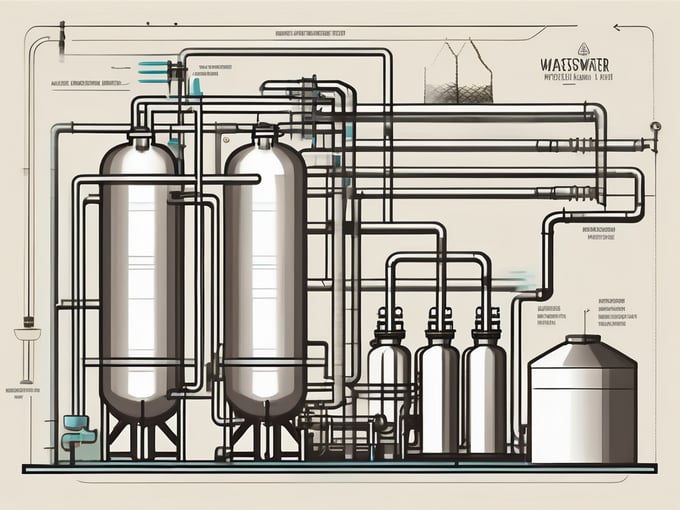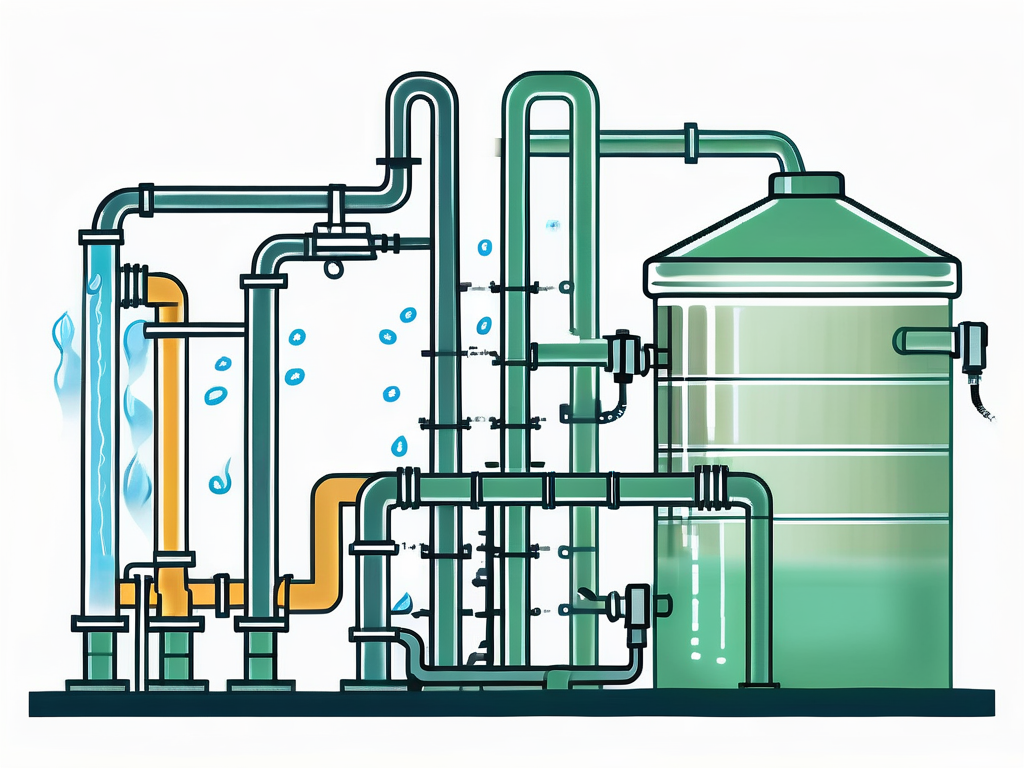
Wastewater: Wastewater Treatment Explained
Wastewater treatment is a critical process in modern societies, designed to remove contaminants from water and make it safe for reuse or discharge into the environment. This process involves a series of steps, each designed to remove or neutralize different types of pollutants.
Understanding wastewater treatment is not only important for professionals in the field, but also for the general public, as it impacts our health, environment, and economy. This glossary aims to provide a comprehensive understanding of the key concepts and processes involved in wastewater treatment.
Introduction to Wastewater
Wastewater, often referred to as sewage, is any water that has been adversely affected in quality by anthropogenic influence. It can originate from a combination of domestic, industrial, commercial or agricultural activities, stormwater runoff or infiltration into the sewer.

Wastewater contains a wide range of contaminants, including physical, chemical, and biological pollutants. The concentration and type of contaminants in the wastewater depend on its source and the type of activities generating it.
Types of Wastewater
There are three main types of wastewater: blackwater, greywater, and yellow water. Blackwater is wastewater from toilets, which contains feces, urine, water, and toilet paper from flush toilets. Greywater is wastewater from non-toilet plumbing systems such as showers, baths, and sinks. Yellow water refers to urine and water from urinals.
Each type of wastewater has different characteristics and requires different treatment processes. For example, blackwater contains high levels of pathogens and nutrients, and thus requires more intensive treatment than greywater.
Characteristics of Wastewater
The characteristics of wastewater can be broadly classified into physical, chemical, and biological. Physical characteristics include temperature, color, odor, and solids content. Chemical characteristics involve parameters like pH, biochemical oxygen demand (BOD), chemical oxygen demand (COD), nutrients (nitrogen and phosphorus), and heavy metals. Biological characteristics refer to the microorganisms present in the wastewater, including bacteria, viruses, and parasites.
These characteristics are important as they determine the treatment methods required to remove the contaminants and the efficiency of these methods.
Wastewater Treatment Process
The wastewater treatment process involves several stages, each designed to remove or neutralize different types of pollutants. The process can be broadly divided into preliminary, primary, secondary, and tertiary treatment stages, followed by disinfection before the treated water is discharged into the environment or reused.
Each stage of the treatment process involves different techniques and technologies, and the choice of these depends on the characteristics of the wastewater and the discharge or reuse requirements.
Preliminary Treatment
Preliminary treatment is the first stage of the wastewater treatment process, designed to remove large objects and grit (sand and other heavy particles) from the wastewater. This is typically achieved through screening and grit removal. The purpose of this stage is to protect the downstream processes from damage or clogging.
Screening involves passing the wastewater through screens to remove large objects such as rags, sticks, and plastic materials. Grit removal involves the use of grit chambers, where the flow velocity of the wastewater is reduced to allow the settlement of grit.
Primary Treatment
Primary treatment is the second stage of the wastewater treatment process, designed to remove suspended and floating materials from the wastewater. This is typically achieved through sedimentation, where the wastewater is held in large tanks (primary clarifiers) to allow the settlement of suspended solids. The settled solids, known as primary sludge, are then removed for further treatment.
The floating materials, such as oil and grease, rise to the surface of the water in the primary clarifiers and are skimmed off. The remaining water, known as primary effluent, is then passed to the secondary treatment stage.
Secondary Treatment
Secondary treatment is designed to remove dissolved and colloidal organic matter from the wastewater. This is typically achieved through biological processes, where microorganisms consume the organic matter as food, converting it into water, carbon dioxide, and energy for their own growth and reproduction.
There are two main types of secondary treatment processes: suspended growth processes, where the microorganisms are maintained in suspension in the wastewater, and attached growth processes, where the microorganisms are attached to a medium and the wastewater is passed over the surface. The treated water from the secondary treatment stage is then passed to the tertiary treatment stage if further treatment is required.
Tertiary Treatment
Tertiary treatment, also known as advanced treatment, is designed to remove specific residual substances, microorganisms, nutrients, and other contaminants that were not removed during the primary and secondary treatment stages. This stage involves various physical, chemical, and biological processes, depending on the characteristics of the wastewater and the discharge or reuse requirements.
Physical processes may include filtration and adsorption, chemical processes may include chemical precipitation and disinfection, and biological processes may include nutrient removal through nitrification and denitrification. The treated water from the tertiary treatment stage is then disinfected and discharged into the environment or reused.
Sludge Treatment
Sludge treatment is an integral part of the wastewater treatment process. The sludge generated during the primary and secondary treatment stages contains a high concentration of organic matter and microorganisms, and requires further treatment before it can be safely disposed of or reused.
Sludge treatment involves several stages, including thickening, digestion, dewatering, and disposal or reuse. The choice of these stages and the techniques and technologies used depend on the characteristics of the sludge and the disposal or reuse requirements.
Sludge Thickening
Sludge thickening is the first stage of the sludge treatment process, designed to reduce the volume of the sludge and increase its solid content. This is typically achieved through gravity thickening, where the sludge is held in a tank to allow the settlement of solids, or flotation thickening, where air is introduced into the sludge to make the solids float to the surface.
The thickened sludge is then passed to the digestion stage for further treatment. The water removed during the thickening stage is returned to the beginning of the wastewater treatment process for treatment.
Sludge Digestion
Sludge digestion is a biological process designed to stabilize the organic matter in the sludge, reducing its volume and mass, and producing biogas that can be used for energy production. There are two main types of sludge digestion processes: aerobic digestion, where the sludge is digested in the presence of oxygen, and anaerobic digestion, where the sludge is digested in the absence of oxygen.
The digested sludge is then passed to the dewatering stage for further treatment. The biogas produced during the digestion process can be used for heating, electricity generation, or vehicle fuel.
Sludge Dewatering
Sludge dewatering is designed to further reduce the volume of the sludge and increase its solid content. This is typically achieved through mechanical processes such as centrifugation, filtration, or drying beds. The dewatered sludge, known as biosolids, can then be disposed of or reused.
The water removed during the dewatering stage is returned to the beginning of the wastewater treatment process for treatment. The biosolids can be disposed of in landfills, incinerated, or used for land application as a soil conditioner or fertilizer.
Disinfection
Disinfection is the final stage of the wastewater treatment process, designed to kill or inactivate pathogenic microorganisms in the treated water before it is discharged into the environment or reused. There are several methods of disinfection, including chlorination, ultraviolet (UV) radiation, and ozonation.
The choice of disinfection method depends on the characteristics of the wastewater, the discharge or reuse requirements, and the local regulations. After disinfection, the treated water, known as effluent, is discharged into a water body or used for non-potable purposes such as irrigation, industrial cooling, or toilet flushing.
Wastewater Treatment Technologies
There are numerous technologies available for wastewater treatment, ranging from conventional activated sludge processes to advanced membrane bioreactors. The choice of technology depends on the characteristics of the wastewater, the discharge or reuse requirements, and the available resources.
Some of the commonly used wastewater treatment technologies include activated sludge process, trickling filters, rotating biological contactors, sequencing batch reactors, membrane bioreactors, and constructed wetlands. Each of these technologies has its own advantages and disadvantages, and the choice of technology should be based on a thorough evaluation of the specific situation.
Activated Sludge Process
The activated sludge process is a type of secondary treatment process that uses aeration and a biological floc composed of bacteria and protozoa to degrade the organic matter in the wastewater. The process involves aeration, sedimentation, and return of activated sludge to the aeration tank.
The activated sludge process is widely used due to its ability to achieve high levels of organic matter and nutrient removal. However, it requires significant energy for aeration and produces a large amount of sludge that needs to be treated and disposed of.
Membrane Bioreactors
Membrane bioreactors (MBRs) are a type of wastewater treatment technology that combines a biological process with membrane filtration. The biological process, which can be an activated sludge process or a biofilm process, degrades the organic matter in the wastewater, while the membrane filtration removes the suspended solids and some of the microorganisms.
MBRs can achieve high levels of organic matter, nutrient, and pathogen removal, and produce a high-quality effluent suitable for reuse. However, they require significant energy for membrane filtration and need regular membrane cleaning or replacement to maintain their performance.
Wastewater Reuse
Wastewater reuse, also known as water recycling or water reclamation, is the process of using treated wastewater for beneficial purposes such as irrigation, industrial cooling, or toilet flushing. Wastewater reuse can help conserve water resources, reduce the discharge of pollutants into the environment, and provide a reliable water supply in water-scarce areas.

However, wastewater reuse requires careful planning and management to ensure the safety and acceptability of the reused water. This includes appropriate treatment to remove the contaminants of concern, monitoring to verify the quality of the reused water, and public education to gain acceptance of the practice.
Types of Wastewater Reuse
There are several types of wastewater reuse, including agricultural reuse, urban reuse, industrial reuse, and environmental reuse. Agricultural reuse involves the use of treated wastewater for irrigation of crops or landscape areas. Urban reuse involves the use of treated wastewater for non-potable uses such as toilet flushing, car washing, or street cleaning.
Industrial reuse involves the use of treated wastewater for industrial processes such as cooling or process water. Environmental reuse involves the use of treated wastewater to enhance wetlands or stream flows. The choice of reuse type depends on the quality of the treated wastewater, the availability of other water sources, and the local regulations and guidelines.
Guidelines for Wastewater Reuse
There are various guidelines and regulations for wastewater reuse, developed by international organizations, national governments, and local authorities. These guidelines specify the quality requirements for the treated wastewater, based on the intended use and the potential health and environmental risks.
For example, the World Health Organization (WHO) has developed guidelines for the safe use of wastewater, excreta, and greywater in agriculture and aquaculture. These guidelines provide a framework for the development of national and local regulations, and include recommendations for treatment, monitoring, and management practices to ensure the safety of wastewater reuse.
Conclusion
Wastewater treatment is a complex process that involves various stages and technologies, each designed to remove or neutralize different types of pollutants. Understanding this process is important for professionals in the field, as well as for the general public, as it impacts our health, environment, and economy.
With the increasing pressure on water resources and the growing awareness of the environmental impacts of wastewater discharge, the importance of wastewater treatment and reuse is expected to continue to grow. Therefore, continuous research and development, public education, and policy support are needed to improve the efficiency and sustainability of wastewater treatment and reuse practices.



